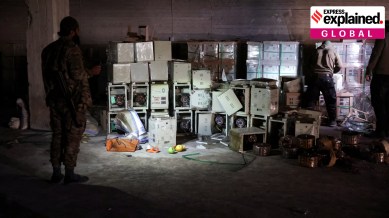Assad’s fall reveals Captagon drug trade in Syria: Everything you need to know
The Captagon trade began industrialising around 2018-2019 as the Assad regime — and other armed groups in Syria -- invested in production facilities, warehouses, and trafficking networks

Since the ouster of former Syrian President Bashar al-Assad, industrial-scale manufacturing facilities of the amphetamine-like stimulant Captagon have been uncovered across the country. Experts believe that sales of the drug — produced mainly in Syria and widely smuggled across West Asia — are estimated to be worth $10 billion per year.
Over the years, the proliferation of Captagon had become a financial lifeline for al-Assad and his associates as Syria continued to struggle due to its economic crisis since the outbreak of the 2011 civil war.
monthly limit of free stories.
with an Express account.
Here is a look at Captagon, its side-effects, and how Syria built its Captagon empire.
What is Captagon?
The currently prominently used Captagon is actually a counterfeit version of a medicine with the same brand name which was first produced in the 1960s by the German company Degussa Pharma Gruppe. They were manufactured to help treat attention deficit disorders, narcolepsy and other conditions.
The original Captagon contained fenethylline, a synthetic drug of the phenethylamine family to which amphetamine also belongs, as per the Al Jazeera report. It was commercially sold in several countries until the 1980s and was banned due to fears of its highly addictive nature.
In the following decades, new illicit tablets, mainly containing amphetamine, labelled Captagon surfaced in Bulgaria from where Balkan and Turkish criminal networks smuggled them to the Arabian Peninsula. The authorities, however, led strict crackdowns on production, which crippled the supply. The drug finally made a comeback post-2011 but this time in Syria, where a bloody civil war had plunged the country into an economic crisis.
What do amphetamine-based drugs do?
According to a 2015 report published by Vox, Captagon pills, like other amphetamine-based drugs, stimulate the central nervous system, providing “a boost of energy, enhance someone’s focus, let someone stay awake for longer periods of time, and produce a feeling of euphoria.”
They, however, don’t help someone gain “superhuman alertness, bravery, strength, or pain resistance” — a person consuming any amphetamine-based drug might feel some sort of placebo effect though, which could lead to erratic behaviours, the report noted.
Captagon or other amphetamine-type drugs usually stay in the blood for around 36 hours. When taken orally, their peak effect occurs one to three hours after consumption, and effects last for as long as seven to 12 hours.
What are their side effects?
Consumption of amphetamines can cause loss of appetite and weight, heart problems such as fast heart rate, irregular heartbeat, increased blood pressure, and heart attack, which can lead to death. They can also cause high body temperature, skin flushing, memory loss, problems thinking clearly, and stroke.
People usually don’t get addicted to prescription amphetamines when they are taken at the right dosage to treat their illnesses. The addiction, however, happens when the drug is consumed to get high or improve performance, Medline Plus noted on its website.
“Addiction can lead to tolerance. Tolerance means you need more and more of the drug to get the same high feeling. And if you try to stop using, your mind and body may have reactions.,” it added.
How did Syria build its Captagon empire?
Assad’s government recognised an opportunity in the cheaply manufactured drug amid Syria’s economic turmoil and the heavy sanctions imposed on it. The Captagon trade began industrialising around 2018-2019 as the Assad regime — and other armed groups in Syria — invested in production facilities, warehouses, and trafficking networks.
This allowed Syria to emerge as the largest producer of Captagon globally, with some production also occurring in Lebanon. Most seized consignments of Captagon originated from Syria, according to data by the New Lines Captagon Trade Project, an initiative of the New Lines Institute think tank. Evidence of the Assad regime’s sponsorship of the Captagon industry is overwhelming, the report published in May said. The Security Office of the 4th Armored Division of the Syrian Arab Army, headed by Bashar al-Assad’s brother Maher oversaw operations and created a coordinated production system, the report added.
(With inputs from AP)